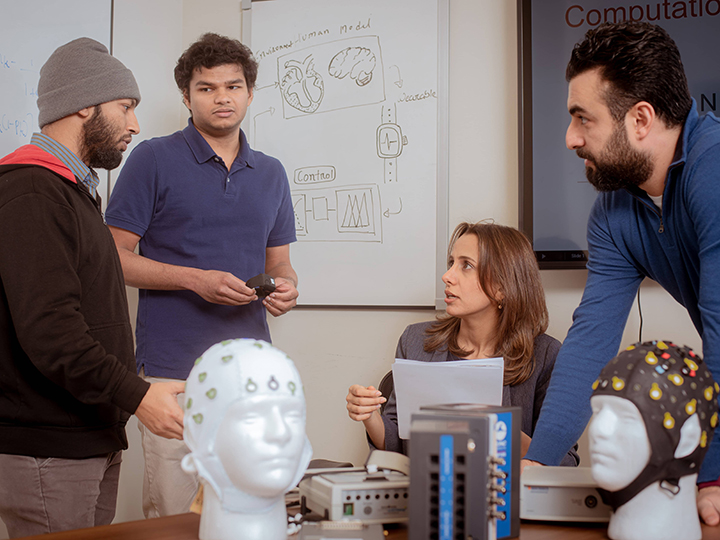Talking With MIT Technology Review Innovator Under 35, Rose Faghih, Ph.D.

Rose Faghih, Ph.D., an assistant professor of electrical and computer engineering, uses HPE Data Science Institute resources to design technology to decrypt human processes.
This year, she received the CAREER award from the National Science Foundation and was featured in the “Women to Watch” section of IEEEs’ Women in Engineering magazine for her stellar accomplishments. Also, Faghih recently made the MIT Technology Review’s Innovator Under 35 list as a visionary.
She discussed the purpose of her projects, motivations, and research during COVID.
Congratulations for your recognition by the MIT Technology Review! Tell us about the project you worked on involving wearable devices.
RF: Thank you! One of my postdoc projects was a part of the Brain Initiative project focusing on designing a closed-loop system for decoding brain activity and performing electrical stimulation to treat severe psychiatric disorders (i.e., patients that didn’t respond to medications anymore and needed brain implants).
I started questioning whether we could decode brain activity before the mental disorder becomes so severe that the patient won’t respond to medication or even before a healthy person develops a mental disorder.
I did my Ph.D. in Electrical Engineering and Computer Science at MIT; based on my training, I view the human body as a complex dynamical system, and I began thinking about using watch-like wearables to decode the brain activity without collecting any brain signals directly. I mean the wearable data can be considered to be the output of a complex dynamical system where the input is the brain activity.
One of the brain functions that is important for mental health disorders is arousal, which can be inferred based on tiny changes in sweat activity and variations in the conductance of skin. Decoding cognitive and emotional arousal states using wearables has been the main focus of my lab.
What are your favorite hobbies?
RF: I started writing poetry in the first grade of elementary school. During my college years, I published two books of poetry, “Our World and Our Words,” and “The Beauty of Nature.” I also created digital art and photo candle art when I was a graduate student. I exhibited my artwork at MIT Graduate Art Soiree Exhibitions.
What are your personal or career motivations/ goals?
RF: I hope my research can contribute to the healthcare system by using technology and data to prevent different disorders and come up with optimal treatment strategies for diseases. My goal is to use engineering and data science to help improve quality of life for everyone all over the world regardless of their socioeconomic status.
What are you currently researching during this quarantine?
RF: There are multiple research problems my students and I are currently addressing. One major effort is on designing algorithms for inferring discrete brain-related events from peripheral signals, decoding latent neurobehavioral states based on inferred brain activity, and designing controllers to regulate the neurobehavioral states.
We are also working on other projects regarding mental workload, hormone secretion modeling and control, seizure severity tracking, and more.
In your opinion, what is the most exciting capability of the supercomputers in the HPE Data Science Institute?
RF: The HPE Data Science Institute provides high-performing cluster resources free of charge to students and faculty. My lab members and I consider having access to these user-friendly supercomputers a great asset to the computationally-intensive data analysis that we work on.
It is great that my lab members can use these supercomputers remotely to smoothly continue our research from home despite the pandemic.